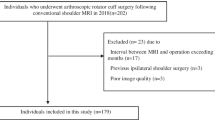Abstract
Introduction
The subscapularis has received little attention in the orthopedic literature, although such lesions are evident in up to 40 % of arthroscopies. An accurate diagnosis is important in clinical practice, as it affects both patient prognosis and surgical planning. The aim of this study was to evaluate the accuracy of preoperative MRI for the identification of subscapularis tears. Our secondary aim involved the identification of factors that may be predictive for the presence of subscapularis tears.
Materials and methods
This retrospective case series included patients undergoing shoulder arthroscopy due to rotator cuff injury. MRI was performed using a 1.5 T unit, and the results were assessed by a musculoskeletal radiologist. The findings were compared to those of arthroscopic inspection.
Results
A total of 93 shoulders were analyzed. The overall accuracy was 82 %, with values of 79 % for partial tears and 89 % for full-thickness tears. Tears requiring repair demonstrated an accuracy of 88 %. Infraspinatus tears, fatty degeneration of the subscapularis, biceps instability and age were identified as predictive factors for the presence of injury.
Conclusions
MRI of the shoulder demonstrated an accuracy of 82 % for the diagnosis of subscapularis tears. The accuracy values for partial and full-thickness tears were 79 and 89 %, respectively.
Level de evidence
III, development of diagnostic criteria with universally applied reference—nonconsecutive patients.

Similar content being viewed by others
References
Yamamoto A, Takagishi K, Osawa T, Yanagawa T, Nakajima D, Shitara H et al (2010) Prevalence and risk factors of a rotator cuff tear in the general population. J Shoulder Elbow Surg 19:116–120
Colvin AC, Egorova N, Harrison AK, Moskowitz A, Flatow EL (2012) National trends in rotator cuff repair. J Bone Jt Surg 94:227–233
Pfirrmann CW, Zanetti M, Weishaupt D, Gerber C, Hodler J (1999) Subscapularis tendon tears: detection and grading at MR arthrography. Radiology 213:709–714
Adams CR, Brady PC, Koo SS, Narbona P, Arrigoni P, Karnes GJ et al (2012) A systematic approach for diagnosing subscapularis tendon tears with preoperative magnetic resonance imaging scans. Arthroscopy 28:1592–1600
Lo IKY, Burkhart SS (2002) Subscapularis tears: arthroscopic repair of the forgotten rotator cuff tendon. Tech Shoulder Elbow Surg 3:282–291
Gavriilidis I, Kircher J, Magosch P, Lichtenberg S, Habermeyer P (2010) Pectoralis major transfer for the treatment of irreparable anterosuperior rotator cuff tears. Int Orthop 34:689–694
Yoo JC, McGarry MH, Jun BJ, Scott J, Lee TQ (2014) The influence of partial subscapularis tendon tears combined with supraspinatus tendon tears. J Shoulder Elbow Surg 23:902–908
Adams CR, Schoolfield JD, Burkhart SS (2010) Accuracy of preoperative magnetic resonance imaging in predicting a subscapularis tendon tear based on arthroscopy. Arthroscopy 26:1427–1433
Garavaglia G, Ufenast H, Taverna E (2011) The frequency of subscapularis tears in arthroscopic rotator cuff repairs: a retrospective study comparing magnetic resonance imaging and arthroscopic findings. Int J Shoulder Surg 5:90–94
Gyftopoulos S, O’ Donnell J, Shah NP, Goss J, Babb J, Recht MP (2013) Correlation of MRI with arthroscopy for the evaluation of the subscapularis tendon: a musculoskeletal division’s experience. Skelet Radiol 42:1269–1275
De Jesus JO, Parker L, Frangos AJ, Nazarian LN (2009) Accuracy of MRI, MR arthrography, and ultrasound in the diagnosis of rotator cuff tears: a meta-analysis. Am J Roentgenol 192:1701–1707
Fuchs B, Weishaupt D, Zanetti M, Hodler J, Gerber C (1999) Fatty degeneration of the muscles of the rotator cuff: assessment by computed tomography versus magnetic resonance imaging. J Shoulder Elbow Surg 8:599–605
Burkhart SS, Brady PC (2006) Arthroscopic subscapularis repair: surgical tips and pearls A to Z. Arthroscopy 22:1014–1027
Smith TO, Daniell H, Geere J-A, Toms AP, Hing CB (2012) The diagnostic accuracy of MRI for the detection of partial- and full-thickness rotator cuff tears in adults. Magn Reson Imaging 30:336–346
Fotiadou AN, Vlychou M, Papadopoulos P, Karataglis DS, Palladas P, Fezoulidis IV (2008) Ultrasonography of symptomatic rotator cuff tears compared with MR imaging and surgery. Eur J Radiol 68:174–179
Lo IKY, Burkhart SS (2003) The etiology and assessment of subscapularis tendon tears: a case for subcoracoid impingement, the roller–wringer effect, and TUFF lesions of the subscapularis. Arthroscopy 19:1142–1150
Choo HJ, Lee SJ, Kim O-H, Seo SS, Kim JH (2012) Comparison of three-dimensional isotropic T1-weighted fast spin-echo MR arthrography with two-dimensional MR arthrography of the shoulder. Radiology 262:921–931
Foad A, Wijdicks CA (2012) The accuracy of magnetic resonance imaging and magnetic resonance arthrogram versus arthroscopy in the diagnosis of subscapularis tendon injury. Arthroscopy 28:636–644
Acknowledgments
No funding was received for this study.
Author information
Authors and Affiliations
Corresponding author
Ethics declarations
Conflict of interest
The authors declare that they have no conflict of interest.
Rights and permissions
About this article
Cite this article
Malavolta, E.A., Assunção, J.H., Guglielmetti, C.L.B. et al. Accuracy of preoperative MRI in the diagnosis of subscapularis tears. Arch Orthop Trauma Surg 136, 1425–1430 (2016). https://doi.org/10.1007/s00402-016-2507-8
Received:
Published:
Issue Date:
DOI: https://doi.org/10.1007/s00402-016-2507-8




